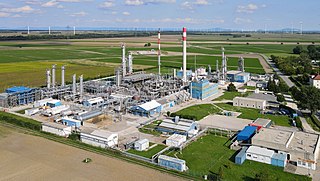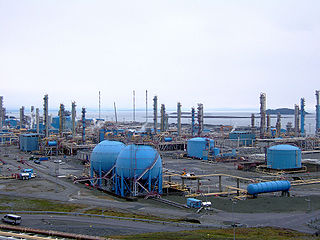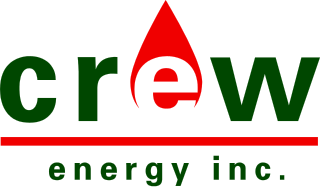
A refinery is a production facility composed of a group of chemical engineering unit processes and unit operations refining certain materials or converting raw material into products of value.
Natural-gas condensate, also called natural gas liquids, is a low-density mixture of hydrocarbon liquids that are present as gaseous components in the raw natural gas produced from many natural gas fields. Some gas species within the raw natural gas will condense to a liquid state if the temperature is reduced to below the hydrocarbon dew point temperature at a set pressure.

Petroleum production in Canada is a major industry which is important to the economy of North America. Canada has the third largest oil reserves in the world and is the world's fourth largest oil producer and fourth largest oil exporter. In 2019 it produced an average of 750,000 cubic metres per day (4.7 Mbbl/d) of crude oil and equivalent. Of that amount, 64% was upgraded from unconventional oil sands, and the remainder light crude oil, heavy crude oil and natural-gas condensate. Most of the Canadian petroleum production is exported, approximately 600,000 cubic metres per day (3.8 Mbbl/d) in 2019, with 98% of the exports going to the United States. Canada is by far the largest single source of oil imports to the United States, providing 43% of US crude oil imports in 2015.
Sherritt International is a Canadian resource company, based in Toronto, Ontario. Sherritt is a world leader in the mining and refining of nickel and cobalt – metals essential for the growing adoption of electric vehicles. Its Technologies Group creates innovative, proprietary solutions for oil and mining companies around the world to improve environmental performance and increase economic value. Sherritt is also the largest independent energy producer in Cuba. Sherritt’s common shares are listed on the Toronto Stock Exchange under the symbol “S”.

Boardwalk Pipeline Partners, LP, which conducts business through its primary subsidiary Boardwalk Pipelines, LP and its subsidiaries, is an energy company based in Houston, Texas. It is a master limited partnership operating in the midstream portion of the natural gas and natural gas liquids (NGLs) industry, primarily providing transportation and storage for those commodities. Boardwalk owns approximately 14,365 miles (23,118 km) of natural gas and NGLs pipelines and underground storage caverns having an aggregate capacity of approximately 205 billion cubic feet (Bcf) of working natural gas and 24.0 million barrels of NGLs. Boardwalk's pipeline system originates in the Gulf Coast region, Oklahoma and Arkansas and extends north and east to the Midwestern states of Tennessee, Kentucky, Illinois, Indiana, and Ohio, and Boardwalk's NGLs pipeline and storage facilities are located in Louisiana and Texas.

The oil and gas industry is usually divided into three major components: upstream, midstream and downstream. The midstream sector involves the transportation, storage, and wholesale marketing of crude or refined petroleum products. Pipelines and other transport systems can be used to move crude oil from production sites to refineries and deliver the various refined products to downstream distributors. Natural gas pipeline networks aggregate gas from natural gas purification plants and deliver it to downstream customers, such as local utilities.
Gassco is a Norwegian state owned company that operates 7,800 kilometres (4,800 mi) of natural gas pipes transporting annually of 100 billion cubic meter (bcm) of natural gas from the Norwegian continental shelf to Continental Europe and Great Britain.

Canada's natural gas liquids industry dates back to the discovery of wet natural gas at Turner Valley, Alberta in 1914. The gas was less important than the natural gasoline - "skunk gas" it was called, because of its distinctive odour - that early producers extracted from it. That natural gas liquid (NGL) could be poured directly into an automobile's fuel tank.

Natural-gas processing is a range of industrial processes designed to purify raw natural gas by removing contaminants such as solids, water, carbon dioxide (CO2), hydrogen sulfide (H2S), mercury and higher molecular mass hydrocarbons (condensate) to produce pipeline quality dry natural gas for pipeline distribution and final use. Some of the substances which contaminate natural gas have economic value and are further processed or sold. Hydrocarbons that are liquid at ambient conditions: temperature and pressure (i.e., pentane and heavier) are called natural-gas condensate (sometimes also called natural gasoline or simply condensate).
Natural gasoline is a liquid hydrocarbon mixture condensed from natural gas, similar to common gasoline (petrol) derived from petroleum.

Kårstø is an industrial facility located near the village of Susort, along the Boknafjorden, in the municipality of Tysvær in Rogaland county, Norway. The site features a number of natural gas processing plants that refine natural gas and condensate from the fields in the northern parts of the North Sea, including the Åsgard, Mikkel, and Sleipner gas fields. The Kårstø processing complex is Europe's biggest export port for natural gas liquids (NGL) and the third largest in the world. The industrial site is also the location for the now-closed Kårstø Power Station.

Natural gas has been used almost as long as crude oil in Canada, but its commercial development was not as rapid. This is because of special properties of this energy commodity: it is a gas, and it frequently contains impurities. The technical challenges involved to first process and then pipe it to market are therefore considerable. Furthermore, the costs of pipeline building make the whole enterprise capital intensive, requiring both money and engineering expertise, and large enough markets to make the business profitable.

The Central Area Transmission System is a natural gas transportation and processing system that transports natural gas through a 404 kilometre pipeline from the Central North Sea to a reception and processing terminal at Teesside in the North East of England.

The natural gas in Qatar covers a large portion of the world supply of natural gas. According to the Oil & Gas Journal, as of January 1, 2011, reserves of natural gas in Qatar were measured at approximately 896 trillion cubic feet ; this measurement means that the state contains 14% of all known natural-gas reserves, as the world's third-largest reserves, behind Russia and Iran. The majority of Qatar's natural gas is located in the massive offshore North Field, which spans an area roughly equivalent to Qatar itself. A part of the world's largest non-associated, natural-gas field, the North Field, is a geological extension of Iran's South Pars / North Dome Gas-Condensate field, which holds an additional 450 trillion cubic feet of recoverable natural-gas reserves.
Inter Pipeline Ltd. is a multinational petroleum transportation and infrastructure limited partnership that is ranked among North America's leading natural gas and NGL's extraction businesses. It is one of Alberta's top 100 companies in terms of profit (85) and assets (94).
Pembina Pipeline is a Canadian corporation that operates transportation and storage infrastructure delivering oil and natural gas to and from parts of Western Canada ; there is also a natural gas processing business that takes place at the Cutbank Complex. Western Canada is the source of all the product transported by its systems. Some of the pipelines and facilities have short term contracts with oil producers while others are long term. For 37 years until 1997 when it went public and established itself as a trust, Pembina was a regular privately owned business. On October 1, 2010 it converted to a corporation from a trust, changing its official name from Pembina Pipeline Income Fund to Pembina Pipeline Corporation. As of 2016 the company had more than 1260 employees, up from 427 in 2010. The company's total assets nearly doubled in 2017.

Crew Energy Inc. is a growth-oriented, liquids-rich natural gas producer, committed to pursuing sustainable per share growth through a balanced mix of financially responsible exploration and development complemented by strategic acquisitions. The Company’s operations are exclusively focused in the vast Montney resource, situated in northeast British Columbia, and include a large contiguous land base. Crew's liquids-rich natural gas areas of Septimus and West Septimus and Groundbirch in British Columbia offer significant development potential over the long-term. The Company has access to diversified markets with operated infrastructure and access to multiple pipeline egress options. Crew’s common shares are listed for trading on the Toronto Stock Exchange under the symbol “CR”.
AltaGas is a North American energy infrastructure company based in Calgary, Alberta. It links natural gas liquids (NGLs) and natural gas to both Canadian and global markets. The company operates in four business segments: utilities, midstream, power and corporate.
The Teesside oil terminal is a major crude oil reception, processing, storage and export facility at Seal Sands, Middlesbrough. It receives and processes crude oil delivered by the subsea NORPIPE pipeline from the Norwegian Ekofisk field and the UK Fulmar and J-Block fields. The terminal includes facilities for exporting stabilised crude oil and liquefied petroleum gases (LPG) by tanker and pipeline.
Tourmaline Oil is a Canadian energy company engaged in the exploration, development, and extraction of crude oil and natural gas. It is headquartered in Calgary, Alberta in Canada. A major natural gas producer, it became the largest natural gas producer in Canada in 2021. It is also the first Canadian oil and gas exploration and development company to directly engage in the liquified natural gas business.








